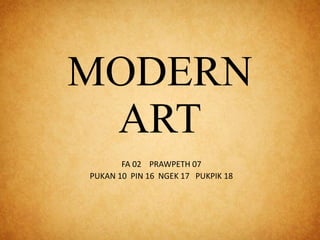More Related Content
What's hot (20)
Viewers also liked
Viewers also liked (20)
Chapter 11 powerpoint- History and Cultures of Europe

Chapter 11 powerpoint- History and Cultures of Europe
Similar to Modern art
Similar to Modern art (20)
Modern and contemporary art presentation By Anuj Kumar Maurya

Modern and contemporary art presentation By Anuj Kumar Maurya
Modern art
- 1. MODERN ART FA 02 PRAWPETH 07 PUKAN 10 PIN 16 NGEK 17 PUKPIK 18
- 2. MODERN ART • Works produced during approximate period 1870 – 1970 • Used new materials, new techniques of painting • Developed new theories about how art should reflect the perceived world
- 3. NEO-CLASSIC • Restoration of classic [Greek and Roman] • Centered at France • Focus on humanism more than religion • Believe that painting is the most valuable in art • Don’t have much decoration
- 5. ROMANTICISM • Contrast of classic • Artist use emotion to create art work • Focus on the truth of life • Looks exciting and inspirational • Emotional type of art • Established by Gericault
- 6. Gericault
- 7. REALISM • Focus on realistic • Believe that truth have it own beauty • Represent social image • Use iron and glass in architecture • Influence from industrial revolution • Artist like to paint the pictures of poor people
- 9. IMPRESSIONISM • Pointillism • Focus on shape and story more than method • Use basic shape and form • Conventional Painting • Use theory of light and shadow • Rough painting • Influence from romanticism
- 10. Claude Monet
- 11. POST-IMPRESSIONSM • Symbolic • Did not inspire from nature • Touching and impression kind of art • People did not accept this type of art • Later became valueable • Technique : color dot
- 12. Van Gogh
- 13. Starry Night • The most famous painting from Van Gogh
- 14. REFERENCE • work sheet from www.artstucafe.com • Work sheet from The Factory Studio And Arthouse • Work sheet from Silapakorn University Camp
